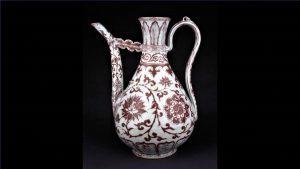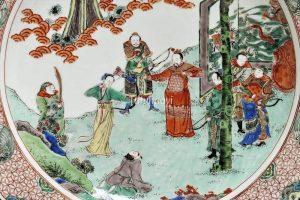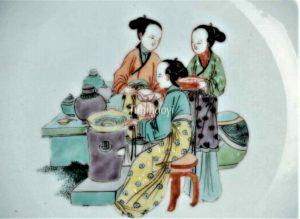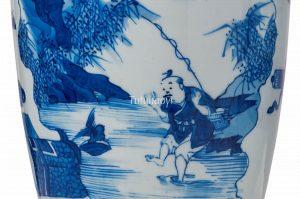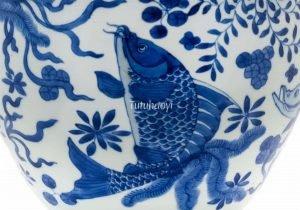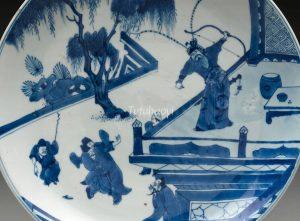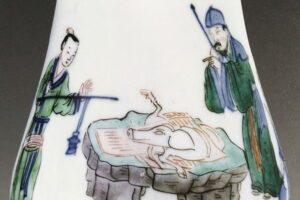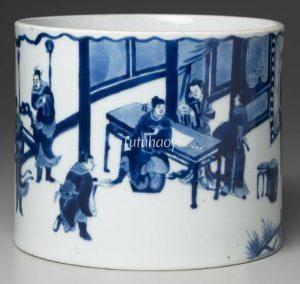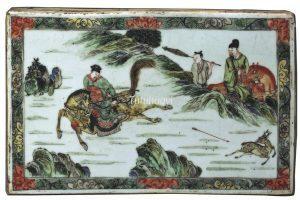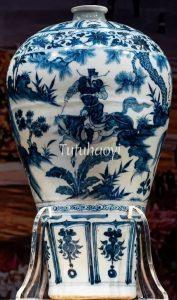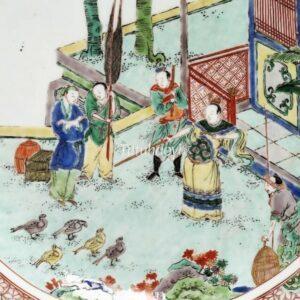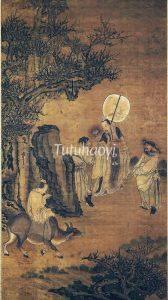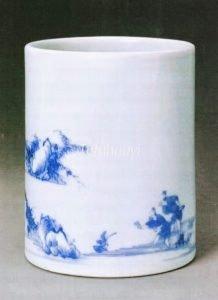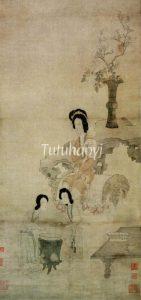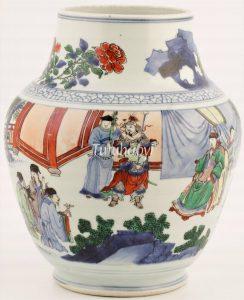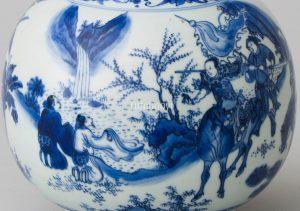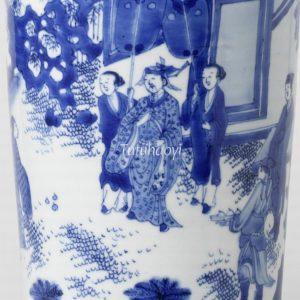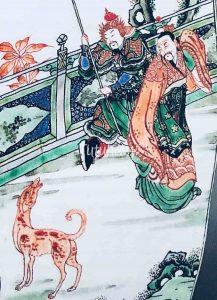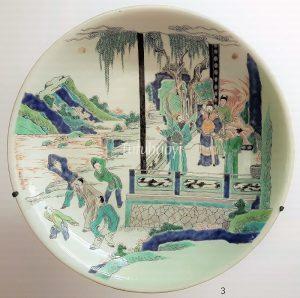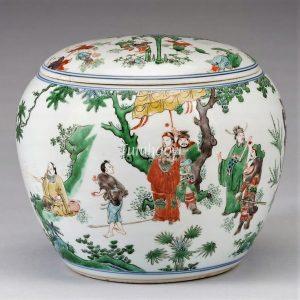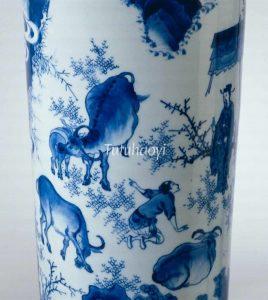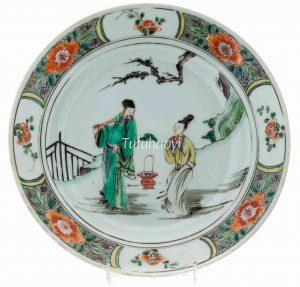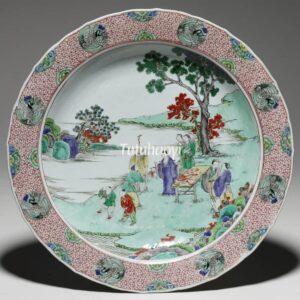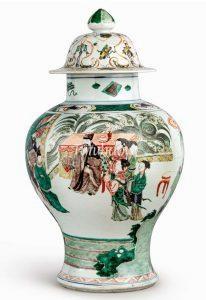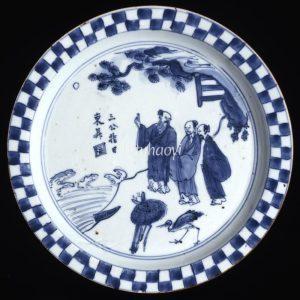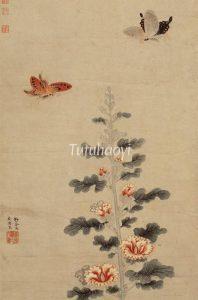Showing Results Containing
Hongwu porcelain with underglaze blue and underglaze red decoration has been the treasure from the beginning of Ming Dynasty which was established by Emperor Taizu Zhu Yuanzhang.
Congratulations on art historian Dr Yibin Ni’s new research into a rare story scene in Chinese pictorial art, which may have puzzled contemporary museum curators and porcelain collectors. Dr Ni has traced the art historical context in which this r...
Pictorial artworks with figural scenes in traditional China often have historical and cultural significance and are not to be mistaken for daily life genre painting. Here is an example and Dr Yibin Ni will explain to you the hidden meaning in the ...
People who are not familiar with Chinese history and parables may have the impression that the above image is a genre painting of fisherman’s daily life. But in fact, there is more meaning to it. Dr Yibin Ni will explain the story in detail and ho...
Through analysing a famous theme that depicts Bo Yi and Shu Qi Stopping the Zhou Army, Dr Yibin Ni has compared a number of porcelain vessels from Ming and Qing dynasties, and demonstrated his unique insight which can facilitate the correct dating...
Many museums and auction houses are often unaware of the pun rebuses hidden in traditional Chinese pictures and have treated them as mere naturalistic ones. Thus, the cultural and social significance contained in the motifs are unfortunately overl...
Story scenes painted on Chinese porcelains are sometimes mysterious and challenging to understand. Dr Yibin Ni, whose specialised research is to demystify figures and story scenes, and decode motifs, symbols and pun rebuses in Chinese art, is here...
Have you wondered why the same story scenes were painted differently on Chinese artworks? How was it painted to present women falling in love on Chinese antique porcelains? Read on to see what Dr Yibin Ni has to say with his analysis.
In Chinese porcelain painting, it can be tricky to interpret a round disc in the sky as a sun or a moon. Knowledge of Chinese culture and pun rebuses are the keys to explain the meanings of the motifs and scenes correctly. Here are some examples…<...
The story of the statesman Bing Ji (丙吉) inquiring about a panting buffalo in ancient China has been illustrated in various forms in traditional Chinese art. It is meant to praise high-ranking officials who can prioritise their duties for their cou...
The traditional theme of ‘Chen Ping Dividing Meat’(陈平分肉) is often mistakenly referred to as Chen ‘Selling Meat’ or even ‘Picture of Selling Meat’ in Chinese art reference books, which reduces a historically significant theme to a mere genre painti...
Feng Menglong (冯梦龙 1574–1646), a Chinese historian, novelist, and poet of the late Ming Dynasty once recorded this tale in his Stories to Caution the World:
In the Tang dynasty, Emperor Xuanzong (r. 712–756) presided over the flourishing ‘Kaiyuan Era’. Early in his reign, he valued learning and t...
The Royal Hunt at Xutian is a pivotal moment in Chapter 20 of Romance of the Three Kingdoms (《三国演义》) by Luo Guanzhong (罗贯中). This episode highlights Cao Cao (曹操) as a domineering minister who ‘held the emperor hostage to command the feudal lords.’
In this scene, Cao Cao arranges a hunting...
The story comes from the Records of the Grand Historian (Shiji 史记), specifically the biography of the Marquis of Huaiyin. It recounts an episode from 206 BCE, during the power struggle between the Chu and Han kingdoms.
Han Xin 韩信, well-versed in military strategy, joined Liu Bang 刘邦 duri...
Jia Chang (贾昌 712–810) from the Tang Dynasty was renowned for his exceptional skills in training roosters for cockfighting. His legendary story is recorded in the Extensive Records of the Ta...
Guo Ziyi (郭子仪 697–781), a native of Huazhou 华州 (a county near present-day Xi’an 西安), was the most prominent general-statesman of the Tang dynasty. For the great part of nearly thirty years and under a succession of four different emperors, he played a key role in maintaining the stability of the country. He helped to
‘Li Mi (李密 582–619) Hanging His Books on His Ox Horns’ is one of the inspirational self-improvement stories in ancient China. It was adopted in the famous Three-Character Classic (三字经 San Zi Jing), written in the 13th century. The primer served as children’s first textbook in elementary...
This is a story of a brave woman who boldly exercised her rhetorical competence, managed to correct the erring ruler and saved her husband from execution. The story of The Wife of the Bow Maker in the State of Jin (晋弓工妻) is recorded in Chapter 6 Convincing and Perceptive (辩通传), Biographies of Exemplary Women (列女...
The story scene refers to an old Chinese saying: in the fight between the sandpiper and the clam, the fisherman has the best of it. This parable came from an ancient Chinese text entitled ‘Strategies of the Warring States (战国策 Zhanguo Ce)’. The book contains anecdotes of diplomacy and warfare during the Warring ...
‘Tiao Mei He Geng 调梅和羹’ is a metaphor that likens the art of governing a country to the adequate seasoning of a stew with salt and sour prunes. The scene is often made up of a group of women or men surrounding a stove, on which a cauldron of food is being cooked, with an assistant holding a container with sour p...
The story scene is originated from an anecdote dating back to the Tang dynasty (618-907). Cui Rong (崔戎, 780-835) is a statesman who is important enough to have a position in the ‘Biographies’ section in the official histories The Old Book of Tang (jiu tang shu 旧唐书), completed in 945, and the New Book of Tang (
Bo Yi (or Boyi, 伯夷) and Shu Qi (or Shuqi, 叔齐) were sons of the ruler of Guzhu (孤竹), a vassal state of the Shang dynasty (商朝, 16th-11th cent. BCE). As the king was getting old, he wanted Shu Qi, his youngest son, to inherit his throne. However, when the father died, Shu Qi asked Bo Yi to take over th...
A gathering of four distinctively different fishes can be read as a pun rebus design expressing an admonishing message ‘qing bai lian jie 清白廉洁’, which literally means ‘pur...
According to the Account of Wu (吴志) in The Records of the Three Kingdoms (三国志), Lu Ji (陆绩), was a native of Wu. At the age of six, he had an opportunity to meet Yuan Shu (袁术), who at the time controlled the region of Jiujiang. Yuan Shu put out some tangerines for him to eat. Lu Ji surreptitiously stuffed three of them in...
Emperor Yang of the Sui dynasty (隋炀帝, r. 606-18) is known for many achievements, such as linking the Yellow and Yangzi Rivers with the man-made Grand Canal, leading successful military campaigns expanding the Sui territory, and being accomplished in the arts. Despite those, Emperor Yang is also considered to have brought...
When the old duke of Jin (晋) passed away, his heir was still in the cradle. It was with the powerful minister Zhao Dun (赵盾)’s support that he succeeded in ascending the throne. Unfortunately, the young duke, who was posthumously given the title Duke Ling of Jin, Jìn Líng Gōng (晋灵公, ? – 607 BCE), became increasingly the o...
The young duke of the State of Jin (晋) who was posthumously given the title Duke Ling of Jin, Jìn Líng Gōng (晋灵公, ? – 607 BCE), has been known as a ‘ruler who does not deserve his title (bu jun 不君)’. His despotic behaviour was enumerated in the records by historiographers. For example, he levied heavy taxes to b...
When the Baron of the Zhou vassal state (周西伯) did a divination with oracle bones for his imminent hunting trip, the message came: ‘You will not catch a small bear or a large bear, but a teacher will be presented to you by the divine power.’ After bathing and fasting for three days, the baron arrived at the River Wei, he ...
When Bing Ji (丙吉 d. 55 BCE) was a chancellor in the Han court, once he encountered the aftermath of a gang fight in the street. Bing Ji passed them without batting an eyelid. Further ahead, a buffalo passed and it looked out of breath. Bing Ji had its owner stopped and inquired about the buffalo’s heavy panting. Bing Ji’...
A fish is an ancient symbol of material prosperity and fertility in China, both because it puns with another word yu 余 meaning ‘abundance’, and because of the...
Qiuhu (秋胡), a native of the state of Lu during the Spring and Autumn period (770-476 BCE), was ordered to take up an official post in the state of Chen a scant five days after his marriage to Jiefu (洁妇), the ‘Loyal Wife’. Five years later, on his way back home, he encountered a woman by the roadside picking mulberry leav...
Young Chen Ping (陈平, ?–178 BCE), later a minister of Western Han dynasty, as being an exemplar of fairness in his everyday work. According to Sima Qian’s (司马迁, 145BCE – ?) famous work Historical Records – Prime Minister Chen’s Family (史记 – 陈丞相世家 ), one day, Chen Ping’s village held a ceremony to offe...
With strategic plans to restore the war-torn country back to order, the talented scholar Li Jing (李靖) was paying a visit to the powerful Lord Yang Su (杨素), who enjoyed luxurious ways of living and female company around him. To Li Jing’s disappointment, Lord Yang did not take his plans seriously. However, Red Fly Whisk (红...
The action of ‘pointing to the sun’ is termed in Chinese as ‘指日 zhi ri’, which sounds and looks exactly the same as (both homophone and homograph of) the phrase ‘指日 zhi ri’ meaning ‘in a few days’ time’. The state of ‘something rising high up’ is ‘高升 gao sheng’ in Chinese, which may be metaphor...
The primary symbolic meaning of the hollyhock (shu kui 蜀葵) is the good wish for longevity. The secondary implication is based on the perennially sun-facing nature of the hollyhock. In the old days, people compared their emperor or statesman to the sun and themselves to the hollyhock, implying that they would alw...
